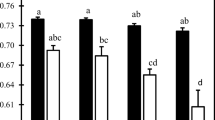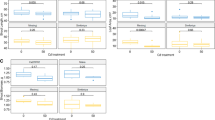Abstract
Tolerant and non-tolerant clones of Chloris barbata Sw. obtained, respectively, from an erstwhile mercury contaminated solid waste dump site near a chloralkali plant and a non-contaminated (control) site were subjected to cadmium-stress by growing the rooted cuttings in water containing CdSO4, 13 and 130 µM. Differences between the two clones in their response to cadmium-stress were noted in root growth, and also with respect to certain biochemical parameters. Whereas catalase activity decreased and non protein-thiol levels increased in the non-tolerant clone, the level of protein-thiol alone increased significantly in the tolerant clone in response to cadmium-stress. No remarkable differences between the clones, however, were noted with respect to total soluble protein, peroxidase activity and lipid peroxidation. Remarkably the two clones responded differently to buthionine sulfoximine, an inhibitor of glutathione and/or phytochelatin synthesis, which inhibited root growth significantly in non-tolerant clone but not in the tolerant clone. Buthionine sulfoximine, nonetheless, could potentate cadmium toxicity in either of the clones, but more effectively in the tolerant clone. The high sensitivity of tolerant-clone to the combined treatment of BSO and Cd in the present study could, therefore, be attributed to the cumulative oxidative stress generated synergistically by BSO and Cd.
Similar content being viewed by others
Abbreviations
- BSO:
-
buthionine sulfoximine
- CAT:
-
catalase
- LP:
-
lipid peroxidation
- POD:
-
peroxidase
- MTs:
-
metallothioneins
- NT:
-
non-tolerant
- NPSH:
-
non-protein thiol
- PSH:
-
protein thiol
- T:
-
tolerant
- TBARS:
-
thiobarbituric acid reactive substances
- TSH:
-
total thiol
- PCs:
-
phytochelatins
References
Bradford A. 1976. A rapid and sensitive method for quantitation of microgram quantities of protein utilising the principle of protein dye-binding. Anal. Biochem., 72: 248–254.
Briat J.F., Lebrun M. 1999. Plant responses to metal toxicity. C. R. Acad. Sci. Paris, 322: 43–54.
Brune A., Urbach W., Dietz K.J. 1995. Differential toxicity of heavy metals is partly related to a loss of preferential extraplasmic compartmentation: a comparison of Cd-, Mo-, Ni-, and Zn-stress. New Phytol., 129: 403–409.
Cobbett C.S. 2000. Phytochelatin biosynthesis and function in heavy-metal detoxification. Cur. Opin. Plant Biol., 3: 211–216.
diToppi L.S., Gabbrielli R. 1999. Response to cadmium in higher plants. Environ. Exp. Bot., 41: 105–130.
Dhindsa R. S., Plumb-Dhindsa P. and Thorpe T. K. 1981. Leaf senescence: correlated with increased levels of permeability and lipid peroxidation and decreased levels of superoxide dismuatse and catalase. J. Exp. Bot., 32: 93–101.
Gupta S.C., Goldshrough P.B. 1991. Phytochelatin accumulation and cadmium tolerance in selected tomato cell lines. Plant Physiol. 97: 306–312.
Harada E., Yamagnchi Y., Koijumi N., Sano H. 2002. Cadmium stress induces production of thiol compounds and transcripts for enzymes involved in sulfur assimilation pathways in Arabidopsis. J. Plant Physiol., 159: 445–448.
Hall J.L. 2002. Cellular mechanisms for heavy metal detoxification and tolerance. J. Exp. Bot., 53: 1–11.
Heath R.L., Packer L. 1968. Photoperoxidation of isolated chloroplasts. I. Kinetics and stoichiometry of fatty acid peroxidation. Arch. Biochem. Biophys., 96: 365–395.
Kleinbaum D.G., Kupper L.L. 1978. Applied regression analysis and other multivariable methods. Duxbury Press. North Scituate, Massachusetts, USA.
Landberg T., Greger M. 2002. Differences in oxidative stress in heavy metal resistant and sensitive clones of Salix viminalis. J. Plant Physiol., 159: 69–75.
Lenka M., Panda K.K., Panda B.B. 1992. Monitoring and assessment of mercury pollution in the vicinity of chloralkali plant IV. Bioconcentration of mercury in situ aquatic and terrestrial plants at Ganjam, India. Arch. Environ. Contam. Toxicol., 22: 195–202.
Lenka M., Das B.L., Panda K.K., Panda B.B. 1993. Mercury tolerance of Chloris barbata Sw. and Cyperus rotundus L. isolated from contaminated sites. Biol. Plant., 35: 443–446.
Maehly A.C., Chance B. 1967. The assay of catalases and peroxidases. In: Methods of Biochemical Analysis, Vol 1, ed. by D. Glick, Interscience Publishers, New York,: 357–424.
Mittal R., Dubey R.S. 1995. Influence of sodium chloride salinity on polyphenol oxidase and catalase activities in rice seedlings differing in salt tolerance. Tropical Sci., 35: 141–149.
Olmos E. Martinez-Solano J. R., Piqueras A., Hellin E. 2003. Early steps in the oxidative burst induced by cadmium in cultured tobaccocells (BY-2 line). J. Exp. Bot., 54: 291–301.
Patra J., Lenka M., Panda B.B. 1994. Tolerance and co-tolerance of the grass Chloris barbata Sw. to mercury, cadmium and zinc. New Phytol., 128: 165–171.
Patra J., Panda B.B. 1998. A comparison of biochemical responses to oxidative and metal stress in seedlings of barley, Hordeum vulgare L. Environ. Pollut. 101: 99–105.
Raskin I. 1996. Plant genetic engineering may help with environmental cleanup. Proc. Natl. Acad. Sci., USA, 93: 3164–3166.
Rauser W.E. 1990. Phytochelatins. Ann. Rev. Biochem., 109: 1141–1149.
Robinson N.J., Tommey A.M., Kuske C., Jackson P.J. 1993. Plant metallothioneins. Biochem. J., 295: 1–10.
Salt D.E., Blaylock M., Kumar N.P.B.A., Dushenkov V., Ensley B., Chet I., Raskin I. 1995. Phytoremediation: a novel strategy for the removal of toxic metals from the environment using plants. Biotechnology, 13: 468–474.
Sandalio L.C., M. Dalurzo H. C., Gomez M., Romero-Puertas M., del Rio L. A. 2001. Cadmium-induced changes in the growth and oxidative metabolism of pea plants. J. Exp. Bot., 52: 2115–2126.
Schat H., Kalff M.M.A. 1992. Are phytochelatins involved in differential metal tolerance or do they merely reflect metal imposed strain? Plant Physiol. 99: 1475–1480.
Schützendübel A., Polle A. 2002. Plant responses to abiotic stress: heavy metal-induced oxidative stress and protection by mycorrhization. J. Exp. Bot., 53: 1351–1365.
Sedlak J., Lindsay R.H. 1969. Estimation of total protein bound, non-protein sulfahydryl groups in tissue with Ellman’s reagent. Anal. Biochem., 25: 1031–1035.
Siedlecka A., Tukendorf A., Skórzyńska-Polit E., Maksymiec W., Wójcik M., Baszyński T., Krupa Z. 2001. Angiosperms (Asteraceae, Convolvulaceae, Fabaceae and Poaceae: other than Brassicaceae). In: Metals in the Environment, analysis by Biodiversity, ed. by M. N. V. Prasad, Marcel Dekker, New York, USA: 171–217.
Steffens J.C. 1990. Heavy metal stress and phytochelatin response. In: Stress Response in Plants: Adaptation and Acclimation Mechanisms, ed. by R.G. Alscher, J. R. Cumming, Wiley-Liss, New York,: 377–394.
Vangronsveld J., Clijsters H. 1994. Toxic effects of metals. In: Plants and the Chemical Elements: Biochemistry, Uptake, Tolerance and Toxicty, ed. by M. E. Farago, VCH, Weinheim, Germany: 149–177.
Zenk M.H. 1996. Heavy metal detoxification in higher plants — a review. Gene, 179: 21–30.
Author information
Authors and Affiliations
Corresponding author
Rights and permissions
About this article
Cite this article
Baisakhi, B., Patra, J., Panigrahy, R.K. et al. Differential antioxidant enzyme and thiol responses of tolerant and non-tolerant clones of Chloris barbata to cadmium-stress. Acta Physiol Plant 25, 357–363 (2003). https://doi.org/10.1007/s11738-003-0017-0
Received:
Issue Date:
DOI: https://doi.org/10.1007/s11738-003-0017-0




